


Aquariusite
Second part: lay out, arrange the aquarium, filling, sand, water, plants, nitrites, nitrates.



Aquariusite
Second part: lay out, arrange the aquarium, filling, sand, water, plants, nitrites, nitrates.
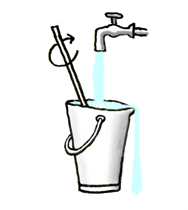
Sand for aquarium. (or gravels)
the sand purchased from an aquarium store must be clean, not to see the aquarium water milky.
For this it should be washed carefully in small quantities in a bucket under running water.
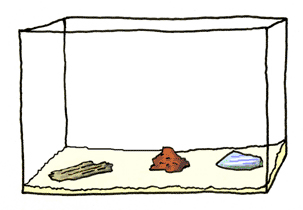
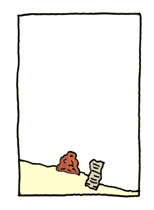
Place the sand at the bottom of the aquarium, or in sloping levels created by decorative stones.
The height of the sand layer must be just enough to fix the plants.
The bacteria necessary for the processing of waste work rather in surface sand, because they need oxygen, so it is not recommended to put layers of sand too high.
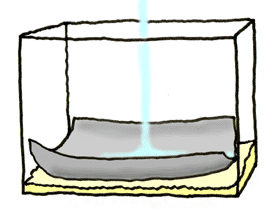
Water filling.
Not to see destroyed the decor when pouring water, you can put a plastic sheet or a large plate, but it is also to prevent the water from becoming too turbid by stirring the sand.
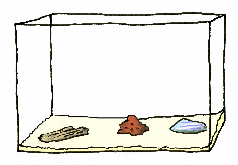
Fill the tank 3/4 full, add the filter, heater and plants that will conceal a little the filter. Large plants must be behind, medium plants in the middle, and small in the foreground.
Once setting the decor , complement the filling.
Let everything run, everything should work as if there were fish.
The filter and / or the bubbler must work to oxygenate the water so that the micro-organisms such as bacteria can multiply.
At the beginning there may be micro-bubbles on the glass and plants, this is normal.
Troubled water in aquarium.
If the water becomes cloudy despite all these precautions, do not panic this will be cleared in a few days.
Anyway there is no question of putting fish in the aquarium for several days, the time to pass the critical period of nitrites that may go up to 2 weeks or a month.

What water must you choose for your aquarium?
Everything depends on the fish you put in your aquarium.
There are exotic fish that are accustomed in almost all waters, such as the guppy, soft or hard water, that does not bother it because it has other priorities.
On the other side, exotic fish like neon (hyphesobricons) require absolutely very soft water.
Since we do not always have soft water on tap, this can cause problems.
Some are lucky to find fresh water at a fountain in a village, otherwise it can be bought in some aquarist stores, or else you could buy an osmosis unit. (A device that converts hard water into soft water)
The evaporation in a hot water aquarium.
Depending on whether we have or not put a glass to cover the tank, the water evaporates faster or slower.
The water that evaporates is pure water and the remaining water is becoming harder.
Mineral salts such as calcium and magnesium, don't evaporate.
If we don't do enough water changes and we only add the tap water, the water might get too hard.
This is when you must add soft water, that is to say water with low mineral content, so a very low hardness.
You can eventually add spring water in bottles, but you have to check the labels for their mineral content.
Do not confuse spring water and mineral water, mineral waters are charged too much in minerals, therefore very hard, they would not be suitable for all fish.
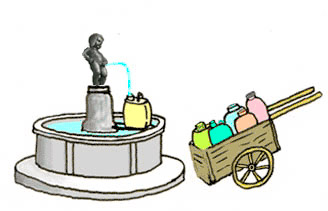
The hardness of water is due to the content of calcium and magnesium which can be measured.
There are products in drops, pills or test strips that are dipped in water taken from the aquarium.
There are also electronic measuring devices.
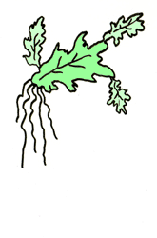

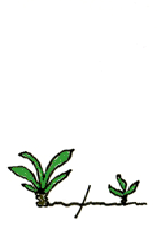
Plants for freshwater aquariums.
There are exotic plants suitable for our hot water tanks.
What plants to choose?
The best thing is to try.
Each aquarium being different, plants will behave differently.
This may vary depending on the temperature, the time of illumination, the hardness or acidity of the water.
Some plants grow very quickly, too quickly, they must even be cut once a week, others do not seem to grow (Cryptocorynes). These plants reproduce in the aquarium but in different ways.
Sometimes it only takes a leaf floating on the water surface and that takes root, as the Sumatra fern that grows very fast and can cover the entire surface of the aquarium, which makes shade for fish that do not like the light, but also a shelter for baby fish (fry).
For others, the stem is cut into two parts and planted next, and for others, it is the root that is cut in two parts for get a new plant, i.e Cryptocorynes growing on a large root called rhizome.
More plants = less nitrates, and less algae on the glass. (Plants absorb nitrates)
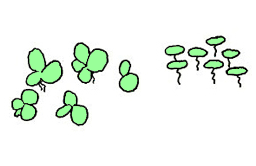
Duckweed water lentils
By their multitude they form a shadow, convenient for fish that need it, but they multiply so fast that they quickly become unmanageable.
Covering the entire surface of the water in the aquarium, they deprive other plants of the light which is necessary to their development.
How to get rid of duckweed? How to remove them
On the day of the cleaning and maintenance of the aquarium, with a dip net or colander we go fishing the lentils.
At first we take out whole heaps, but at the end we have to get them out one by one and we should not forget one, because due to their rapid proliferation we should have to start all over again after a few days.
Thereafter we must check every day if there are no water lentils (duckweed) forgotten in a corner that are developing.
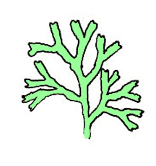
The riccia is a moss formed from tiny leaves floating on the water surface and is highly prized by the fry (baby fish) who find a good hiding place from predators.
In addition, the riccia naturally contains small worms that are good food for fry.
Each leaf of this moss divides into two new leaves to infinity, resulting in a tangle in which no big fish comes to venture.
When, after how many days can I put fish in my new aquarium?
Not before having past the critical period: the rise of nitrites (danger).
It is very important to read the following paragraph.
For exotic fish in our rivers, the process is the same to achieve a balance of transformations nitrites -> nitrates.
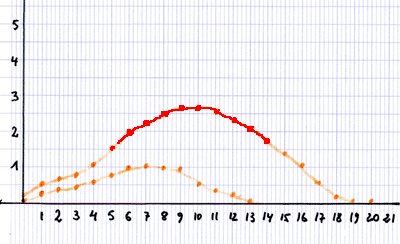
Nitrites, bacteria.
In a newly installed aquarium there are no bacteria or at least not enough to make the transformation of waste and fish excrement. Hence the rise of nitrites, which to a degree becomes lethal for fish.
These nitrites must absolutely be converted into nitrates, nitrates are absorbed by plants.
Where to find these bacteria?
They are naturally on plants that you buy as well as in plants water. But not sufficient, so it is necessary to breed them by feeding them with fish food that you have finely crushed, but beware of not polluting the aquarium.
If we test the nitrites we see that the nitrite level rises every day for one week or more, then falls gradually to hit zero.
It is then that we know that bacteria are numerous enough to do their job.
And only then, we can begin to introduce some fish. Preferably 1 or 2 at a time.
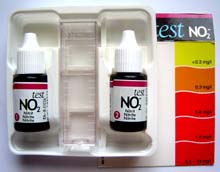
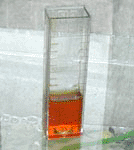
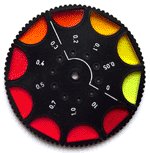
To accelerate the process of nitrites.
We add in the new aquarium, a little sand and a bit of siphoned waste, collected in an aquarium that is running from a long time, or a rough and porous stone that carries with it all kinds of micro-organisms necessary for the proper functioning of the aquarium.
Nitrates.
After the passage of nitrites, nitrates start rising because bacteria have transformed the nitrites into nitrates.
If the fish tank is fairly well planted and not crowded by voracious fish, the nitrate level will remain very low.
If this is not the case, you need to change more water and when the vegetation becomes denser, remove leaves or wilted plants because they release the nitrates that they had stored.
Nitrates can also be measured, the rate should not exceed 30 mg / liter
If the water is milky cloudy the first days after water filling, it is normal this will clear up within a week. The sand was probably not washed enough. But if the water is cloudy or colored after more time, then there is something else.
Eg if the water becomes opaque green, it may be due to micro-algae (phytoplankton) produced by too much brightness.
Reduce the light or cut it off for a few days, normally this will be resolved by itself , because in the aquarium is also the zooplankton which will multiply by eating phytoplankton and the water will be clear again.
Otherwise we add some daphnia (water fleas) that are found in gardens water tanks, then the fish will eat the daphnia.
If the water is cloudy white it can also be due to dead micro-algae or an overgrowth of bacteria.
If the water is yellow, it means it is too old ,the color is due to waste.
If the water is cloudy, it may be the mechanical filter that is incorrectly mounted and rejects all the organic materials that it sucks.
If the water is brown, it can come from peat (turf) or a special aquarium wooden stump (mangrove root) that has not boiled long enough, or does not have soaked long enough in water to lose its tannin, (natural coloring).
The mangrove roots in the aquarium.
They make the water acidic, the water is colored in brown and unleashes substances in water that imitates the Amazons rivers water.
Many of the exotic fish that we find in our aquariums live in these waters.

Snails. How to catch them.
Sometimes after buying a plant, we are faced to a multitude of snails in the aquarium.
At first it may seem fun, but we are quickly disillusioned when we see the damage they cause on the plants leaves.
Snails have a rasping tongue (radula) with teeth, and when they lick the leaves to eat the algae which are on them, they deteriorate the leaves, which fade after.
We must then quickly get the snails out.
To catch them we put a lettuce leaf that has been boiled for a few seconds and we wait till they all come to eat before catching them.
Another trick, they like pink pills "Infusyl". (Food for fry).
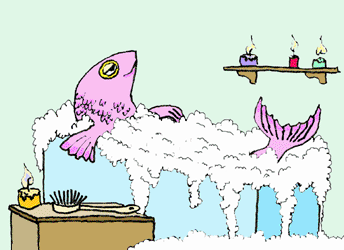
Help I have a lot of foam on the water of my aquarium!
An aquarium that is already running for some time and is furthermore densely populated, has inevitably water that is loaded in organic materials, for example. (Organic materials result mainly from the food that we throw in the aquarium)
This is often observed by the yellowish water, less crystalline than before.
This foam or froth may be very abundant during the rainy days, and completely fill up the aquarium.
This is very bad for the oxygenation of the water because it has no more contact with the air on the surface.
In sea water we use a skimmer to avoid this, in a freshwater aquarium we simply change a part of the aquarium water more often, 1/10th per week for a well populated aquarium, and more for a crowded aquarium.
Of course it also varies if you feed fish a little or too much.

aller à:
Part 1 freshwater aquarium advice(version mobile)
3rd part, The easy viviparous and oviparous exotic fish.
4th part, easy exotic aquatic plants.
frogs,toads,tadpoles,feed,raise,evolution(version mobile)
conseils aquarium eau douce
conseils aquarium eau douce (version mobile)
2ème Partie aménagement, installation, plantes, bactéries, nitrites.
2ème Partie aménagement, installation, plantes, bactéries, nitrites. (version mobile)
Poissons exotiques (version mobile)
Plantes exotiques aquatiques (version mobile)
Transporter, introduire, maladies. (version mobile)
Reproduction danios, cultures-infusoires. (version mobile)
freshwater ( in english ) aquarium.
aller à:
accueil AQUARIUSITE aquarium eau de mer.
créer et démarrer un aquarium récifal,
créer un aquarium récifal, (version mobile)
pontes, poissons clowns, amphiprions,
bébés clowns, élevages,
décor polystyrène pour aquar...,
phytoplancton, zooplancton,
poissons Mandarins Synchiropus,
construire, coller son aquari...
aller à:
nourrir des têtards (version mobile).
Têtards, métamorphose de l'oeuf à la grenouille (version mobile)
grenouilles têtards(version ordinateur)
élevage vers à soie.
élevage vers à soie. (version mobile).
accueil KALIMERA.je.rêve.
aller à:
commentaires livre d'or.